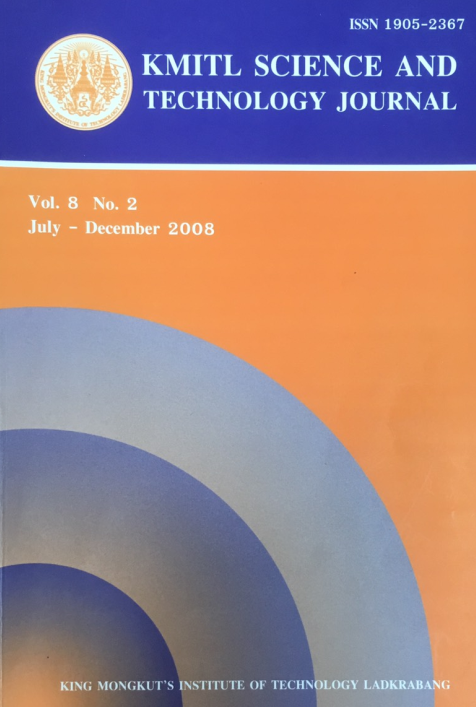Application of High Electronic Field Pulses for Sugar Cane Processing
Main Article Content
Abstract
The effect of high electric field pulses (HELP) on cell disintegration of sugar cane was investigated. The sugar cane was treated at different field strength (4 to 5 kV) and pulse number (10 to 80 pulses). The juice yield as well as mass transfer of HELP pre-treated sample was measured and compared with heated (20 min, 70º C) or untreated sample. The results showed that using HELP treatment at 4 to 5 kV the sugar cane cells could be effectively disintegrated. The mass transfers of HELP treated samples were comparable to heat treated samples. The juice yield of HELP pretreated samples was higher (74.5% at 5kV, 20 pulses) than heat treated (73.2%) and untreated sugar cane (65.5%). The energy consumption for HELP disintegration of sugar cane (17 kJ/ kg at 5kV and 20 pulses) was 10 times less when compared to heat treatment (171 kJ/ kg). Additionally the cell disintegration using HELP occurred faster (less than 2 min with 1Hz pulses frequency and 80 pulses) than thermal disintegration (20 min at 70° C).
KEYWORDS: Sugar cane, high electric field pulses, juice yield
E-mail: egmne@mahidol.ac.th
Article Details
Copyright Transfer Statement
The copyright of this article is transferred to Current Applied Science and Technology journal with effect if and when the article is accepted for publication. The copyright transfer covers the exclusive right to reproduce and distribute the article, including reprints, translations, photographic reproductions, electronic form (offline, online) or any other reproductions of similar nature.
The author warrants that this contribution is original and that he/she has full power to make this grant. The author signs for and accepts responsibility for releasing this material on behalf of any and all co-authors.
Here is the link for download: Copyright transfer form.pdf
References
[2] Bliesener, K. M., Miehe, D.and Buchholz, K. 1991. Process development in the dewatering of cossetes. Zuckerind. 116(11), 978–986.
[3] Coster, H. G. L. 1965. A quantitative analysis of the voltage-current relationships of fixed charge membranes and the associated property of "punch-through". Biophys. J. 5, 668–689.
[4] Williams, E. and Bradley, J. 1967. Steady-state membrane hyperpolarization by large applied currents in Nitella translucens. Biophys. J. 8, 145–147.
[5] Raso J. and Heinz V. 2006. Pulsed Electric Fields Technology for the Food Industry. Springer.
[6] Bazhal, M. and Vorobiev, E. 2000. Electrical treatment of apple cossettes for intensifying juice pressing, J. Sci. Food Agric. 80, 1668–1674.
[7] Flaumenbaum, B. L. 1968. Anwendung von Elektoplasmolyse bei der Herstellung von Fruchtsäfte. Flüss. Obst 35, 19–20.
[8] Geulen, M., Teichgreber, P. and Knorr, D. 1994. Zellaufschluß durch electrische Hochspannungsimpulse. ZFL 45(7/8), 24–27.
[9] Eshtiaghi, M. N. and Knorr D. 2000. Anwendung elektrisher Hochspannungsimpulse zum Zellaufschluß bei der Saftgewinnung am Beispiel von Weintrauben. Lebensmittel- und Verpackungstechnik 45(1), 23–27.
[10] Bouzrara, H. and Vorobiev, E. 2000. Beet juice extraction by pressing and pulsed electric fields. Int. sugar J. 102(1216), 194–200.
[11] Eshtiaghi, M. N. and Knorr, D. 1999. Method for treating sugar beet. International Patent; Patent Nr. WO 99/6434.
[12] Eshtiaghi, M. N. and Knorr, D. 2002. High electric field pulse treatment: potential for sugar beet processing, J. Food Eng 52, 265–272.


